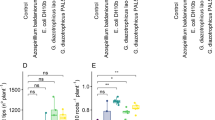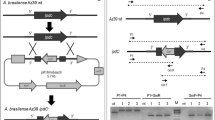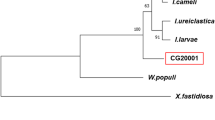Abstract
The use of coinoculations of indole-3-acetic acid-synthesizing bacteria has become increasingly common in agriculture. Different bacterial isolates are capable of synthesizing IAA. Depending on the amount, IAA can promote, inhibit, or modify the growth and development of plants. However, little is known about the effect of auxins on plants under coinoculation conditions. The present study aimed to verify whether coinoculation with indole-3-acetic acid (IAA)-synthesizing bacteria may or may not harm plant development in three tomato genotypes with different sensitivities to auxins: Micro-Tom (MT), diageotropica (dgt) (low auxin sensitivity) and Entire (high auxin biosynthesis). The experiment was conducted in a completely randomized design with six replicates and eight treatments: control; Bacillus velezensis (BV); B. pumilus (BP); Azospirillum brasilense (AZ); B. velezensis + Bacillus pumilus (BV + BP); B. velezensis + A brasilense (BV + AZ); B. pumilus + A brasilense (BP + AZ); B. velezensis + Bacillus pumilus + A. brasilense (BV + BP + AZ), for each tomato genotype. The parameters analyzed were dry shoot and root weight, plant height, and leaf area. The results showed an increase in root dry weight with BV + BP + AZ treatment in the MT genotype, an increase in shoot dry weight in the dgt genotype with BV and no increase in any parameter in the Entire genotype for the analyzed parameters. The results also showed that coinoculation with BP + AZ decreased the shoot dry weight, dry root weight, and leaf area values of the dgt and Entire genotypes. Coinoculations with BP + AZ reduced the parameters analyzed in the dgt genotype, which is insensitive to the IAA and Entire genotypes and is sensitive. In addition, coinoculation with BV + BP + AZ, which provided the highest IAA concentration, increased the dry root weight in the MT genotype. These results suggest that the reduction in plant development caused by coinoculation is not related to IAA synthesis produced by bacteria but is probably due to negative interference in the interaction mechanisms between plants and bacteria and might also be due to negative bacteria–bacteria interactions.






Similar content being viewed by others
References
Adeniji AA, Babalola OO (2019) Bacillus velezensis: phylogeny, useful applications, and avenues for exploitation. Appl Microbiol Biotechnol 103:3669–3682
Albert M, Werner M, Proksch P, Fry S, Kaldenhoff R (2004) The cell wall-modifying xyloglucan endotransglycosylase/hydrolase LeXTH1 is expressed during the defense reaction of tomato against the plant parasite Cuscuta reflexa. Plant Biol 6:402–407
Apine O, Jadhav J (2011) Optimization of medium for indole-3-acetic acid production using Pantoea agglomerans strain PVM. J Appl Microbiol 110:1235–1244
Bulgarelli D, Schlaeppi K, Spaepen S, Van Themaat EVL, Schulze-Lefert P (2013) Structure and functions of the bacterial microbiota of plants. Ann Rev Plant Biol 64:807–838
Cao Y, Pi H, Chandrangsu P, Li Y, Wang Y, Zhou H, Xiong H, Helmann JD, Cai Y (2018) Antagonism of two plant-growth promoting Bacillus velezensis isolates against Ralstonia solanacearum and Fusarium oxysporum. Sci Reports 8:1–14
Chen R, Baluška F (2013) Polar auxin transport. Springer
Davies PJ (2013) Plant hormones: physiology, biochemistry and molecular biology. Springer Science & Business Media
Fan B, Blom J, Klenk H-P, Borriss R (2017) Bacillus amyloliquefaciens, Bacillus velezensis, and Bacillus siamensis form an “operational group B. amyloliquefaciens” within the B. subtilis species complex. Front Microbiol 8:22
Felici C, Vettori L, Giraldi E, Forino LMC, Toffanin A, Tagliasacchi AM, Nuti M (2008) Single and coinoculation of Bacillus subtilis and Azospirillum brasilense on Lycopersicon esculentum: effects on plant growth and rhizosphere microbial community. Appl Soil Ecol 40:260–270
Ferreira LDVM, De Carvalho F, Andrade JFC, Oliveira DP, De Medeiros FHV, Moreira FMDS (2020) Coinoculation of selected nodule endophytic rhizobacterial strains with Rhizobium tropici promotes plant growth and controls damping off in common bean. Pedo 30(1):98–108
Grossmann K (2010) Auxin herbicides: current status of mechanism and mode of action. Pest Manag Sci 66:113–120
Halliday KJ, Martínez-García JF, Josse E-M (2009) Integration of light and auxin signaling. Cold Spring Harb Perspect Biol 1:a001586
Janisiewicz W (1996) Ecological diversity, niche overlap, and coexistence of antagonists used in developing mixtures for biocontrol of postharvest diseases of apples. Phytopathol 86:473–479
Jiang C-H, Yao X-F, Mi D-D, Li Z-J, Yang B-Y, Zheng Y, Qi Y-J, Guo J-H (2019) Comparative transcriptome analysis reveals the biocontrol mechanism of Bacillus velezensis F21 against Fusarium wilt on watermelon. Front Microbiol 10:652
Kaur N, Sharma P, Sharma S (2015) Coinoculation of Mesorhizobium sp. and plant growth promoting rhizobacteria Pseudomonas sp. as bioenhancer and biofertilizer in chickpea (Cicer arietinum L.). Legume Res. An Int J 38(3):367–374
Keswani C, Singh SP, Cueto L, García-Estrada C, Mezaache-Aichour S, Glare TR, Borriss R, Singh SP, Blázquez MA, Sansinenea E (2020) Auxins of microbial origin and their use in agriculture. Appl Microbiol Biotechnol 104(20):8549–8565
Korir H, Mungai NW, Thuita M, Hamba Y, Masso C (2017) Coinoculation effect of rhizobia and plant growth promoting rhizobacteria on common bean growth in a low phosphorus soil. Front Plant Sci 8:141
Ladha, J, Barraquio, W, Revilla, L (1997) Isolation of endophytic diazotrophic bacteria from wetland rice. In Opportunities for Biological Nitrogen Fixation in Rice and Other Non-Legumes. Springer, 15–24.
Li X-g, Zhang Tl, Wang XX, Hua K, Zhao L, Han ZM (2013) The composition of root exudates from two different resistant peanut cultivars and their effects on the growth of soil-borne pathogen. Int J Biol Sci 9(2):164
Marimuthu S, Subbian P, Ramamoorthy V, Samiyappan R (2002) Synergistic effect of combined application of Azospirillum and Pseudomonas fluorescens with inorganic fertilizers on root rot incidence and yield of cotton/Synergistische Wirkung der kombinierten Anwendung von Azospirillum und Pseudomonas fluorescens mit anorganischen Düngern auf die Wurzelfäule und den Ertrag von Baumwolle. Zeitschrift für Pflanzenkrankheiten und Pflanzenschutz/J Plant Dis Protect 109(6):569–577
Mcsteen P (2010) Auxin and monocot development. Cold Spring Harb Perspect Biol 2:a001479
Mommer L, Kirkegaard J, van Ruijven J (2016) Root–root interactions: toward a rhizosphere framework. Trends Plant Sci 21(3):209–217
Phillips KA, Skirpan AL, Liu X, Christensen A, Slewinski TL, Hudson C, Barazesh S, Cohen JD, Malcomber S, Mcsteen P (2011) vanishing tassel2 encodes a grass-specific tryptophan aminotransferase required for vegetative and reproductive development in maize. Plant Cell 23:550–566
Potters G, Pasternak TP, Guisez Y, Palme KJ, Jansen MA (2007) Stress-induced morphogenic responses: growing out of trouble? Trends Plant Scie 12(3):98–105
Probanza A, Garcıa JL, Palomino MR, Ramos B, Mañero FG (2002) Pinus pinea L. seedling growth and bacterial rhizosphere structure after inoculation with PGPR Bacillus (B. licheniformis CECT 5106 and B. pumilus CECT 5105). Appl Soil Ecol 20(2):75–84
Raupach GS, Kloepper JW (1998) Mixtures of plant growth-promoting rhizobacteria enhance biological control of multiple cucumber pathogens. Phytopathol 88:1158–1164
Reid AE, Kim SW, Seiner B, Fowler FW, Hooker J, Ferrieri R, Babst B, Fowler JS (2011) Radiosynthesis of C-11 labeled auxin (3-indolyl [1-11C] acetic acid) and its derivatives from gramine. J Label Comp Radiopharm 54:433–437
Rondina ABL, Dos Santos Sanzovo AW, Guimarães GS, Wendling JR, Nogueira MA, Hungria M (2020) Changes in root morphological traits in soybean coinoculated with Bradyrhizobium spp. and Azospirillum brasilense or treated with A. brasilense exudates. Biol Fert Soils 56:1–13
Santos RM, Kandasamy S, Rigobelo EC (2018) Sugarcane growth and nutrition levels are differentially affected by the application of PGPR and cane waste. MicrobiologyOpen 7(6):e00617
Sarwar M, Kremer R (1995) Determination of bacterially derived auxins using a microplate method. Lett Appl Microbiol 20:282–285
Sasse J, Martinoia E, Northen T (2018) Feed your friends: do plant exudates shape the root microbiome? Trends Plant Sci 23(1):25–41
Sergeeva E, Liaimer A, Bergman B (2002) Evidence for production of the phytohormone indole-3-acetic acid by cyanobacteria. Planta 215:229–238
Vestberg M, Kukkonen S, Saari K, Parikka P, Huttunen J, Tainio L, Devos N, Weekers F, Kevers C, Thonart P (2004) Microbial inoculation for improving the growth and health of micropropagated strawberry. Appl Soil Ecol 27:243–258
Werner TS, Motyka V, Laucou V, Smets R, Van Onckelen H, Schmülling T (2003) Cytokinin-deficient transgenic Arabidopsis plants show multiple developmental alterations indicating opposite functions of cytokinins in the regulation of shoot and root meristem activity. Plant Cell 15(11):2532–2550
Zhang J, Chen R, Xiao J, Qian C, Wang T, Li H, Ouyang B, Ye Z (2007) A single-base deletion mutation in SlIAA9 gene causes tomato (Solanum lycopersicum) entire mutant. J Plant Res 120:671–678
Funding
This study was supported by capes (Grant No. 001) to Laiana Lana Bentes Lobo
Author information
Authors and Affiliations
Contributions
Laiana Lana Bentes Lobo executed the trial and analyzed the results. Maura Santos dos Reis Andrade da Silva made the graphics. Rogério Falleiros Carvalho and Everlon Cid Rigobelo corrected the text.
Corresponding author
Ethics declarations
Conflict of Interest
The authors declare no conflicts of interest.
Additional information
Handling Editor: James Campanella.
Publisher's Note
Springer Nature remains neutral with regard to jurisdictional claims in published maps and institutional affiliations.
Supplementary Information
Below is the link to the electronic supplementary material.
Rights and permissions
About this article
Cite this article
Lobo, L.L.B., da Silva, M.S.R.d., Carvalho, R.F. et al. The Negative Effect of Coinoculation of Plant Growth-Promoting Bacteria Is Not Related to Indole-3-Acetic Acid Synthesis. J Plant Growth Regul 42, 2317–2326 (2023). https://doi.org/10.1007/s00344-022-10706-1
Received:
Accepted:
Published:
Issue Date:
DOI: https://doi.org/10.1007/s00344-022-10706-1




